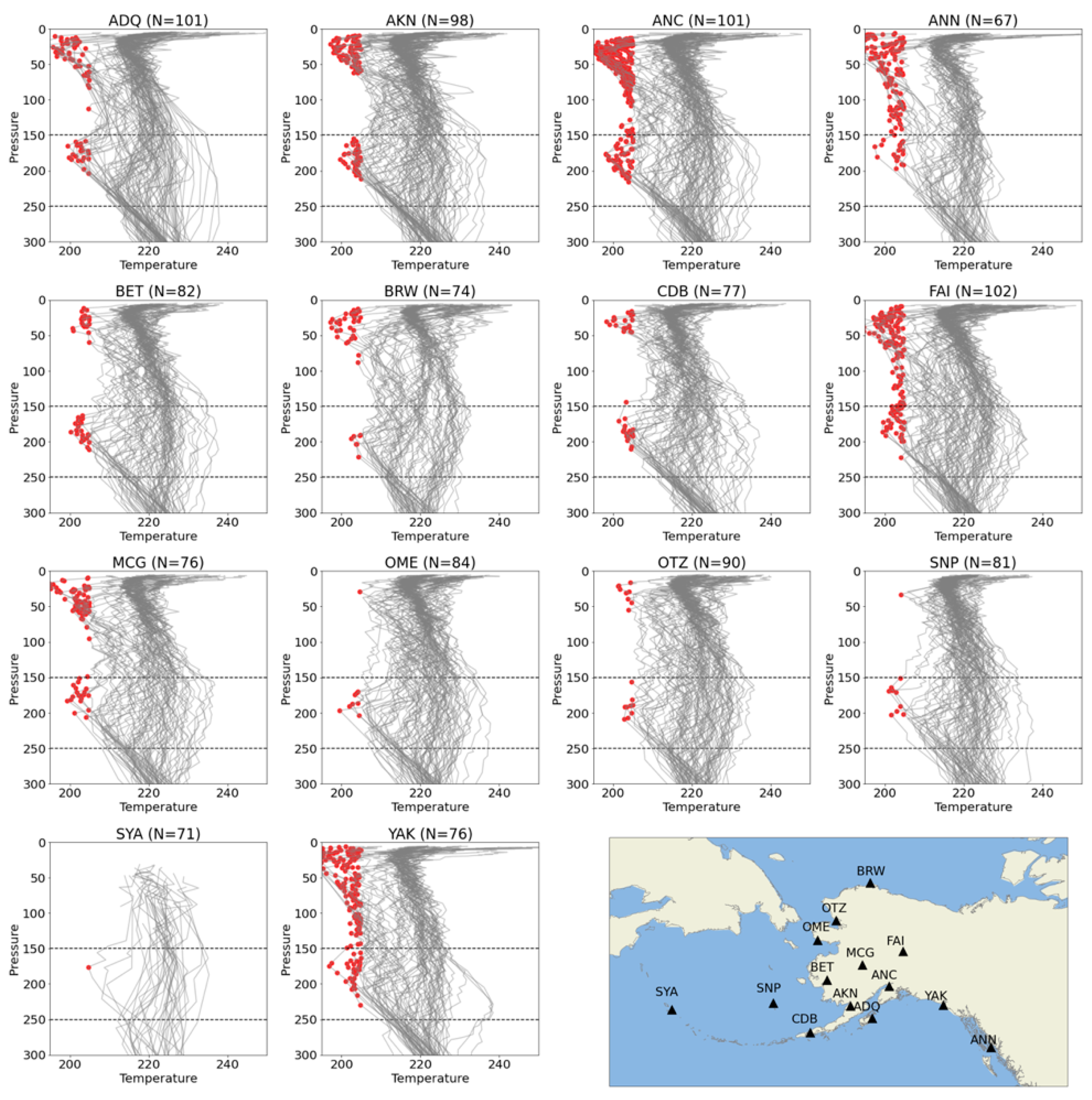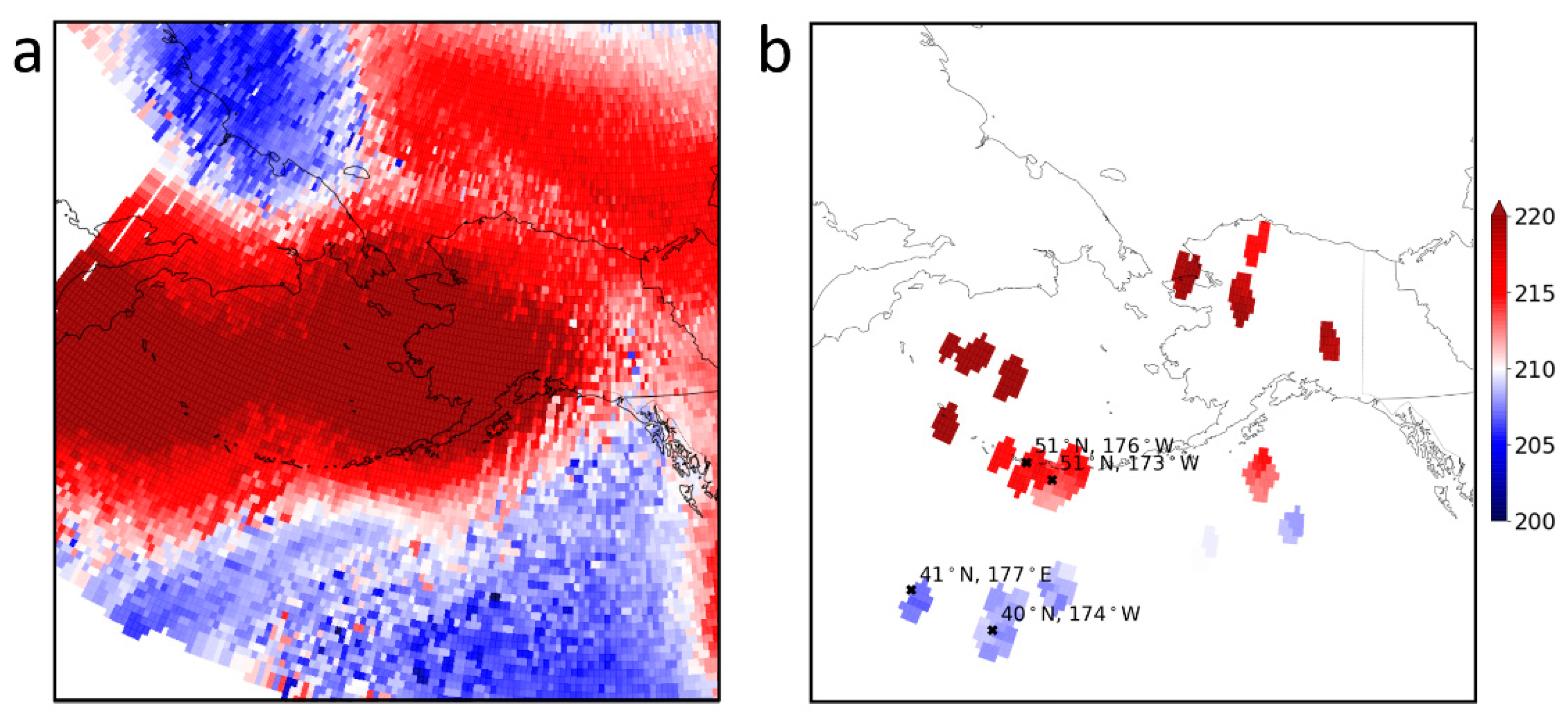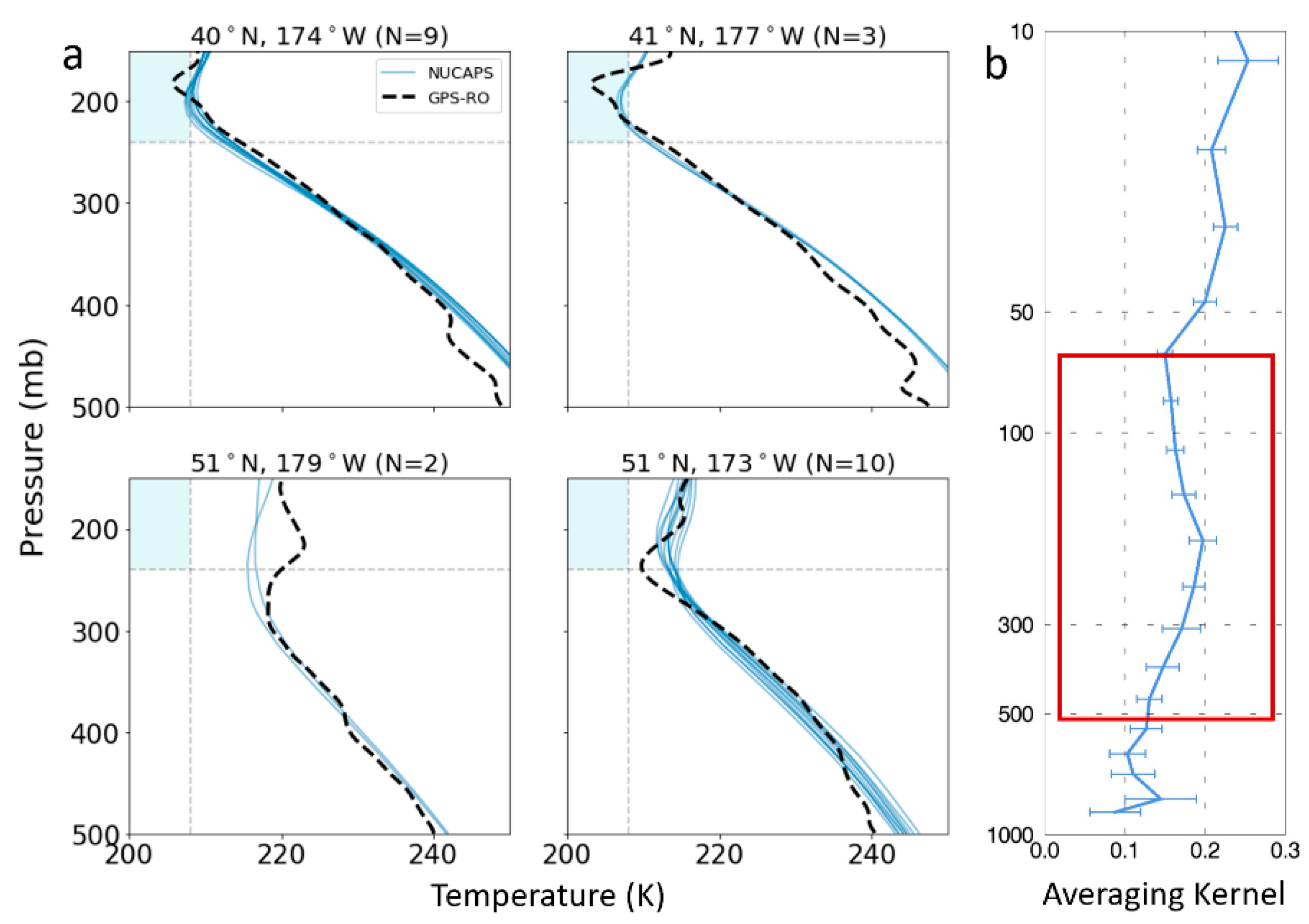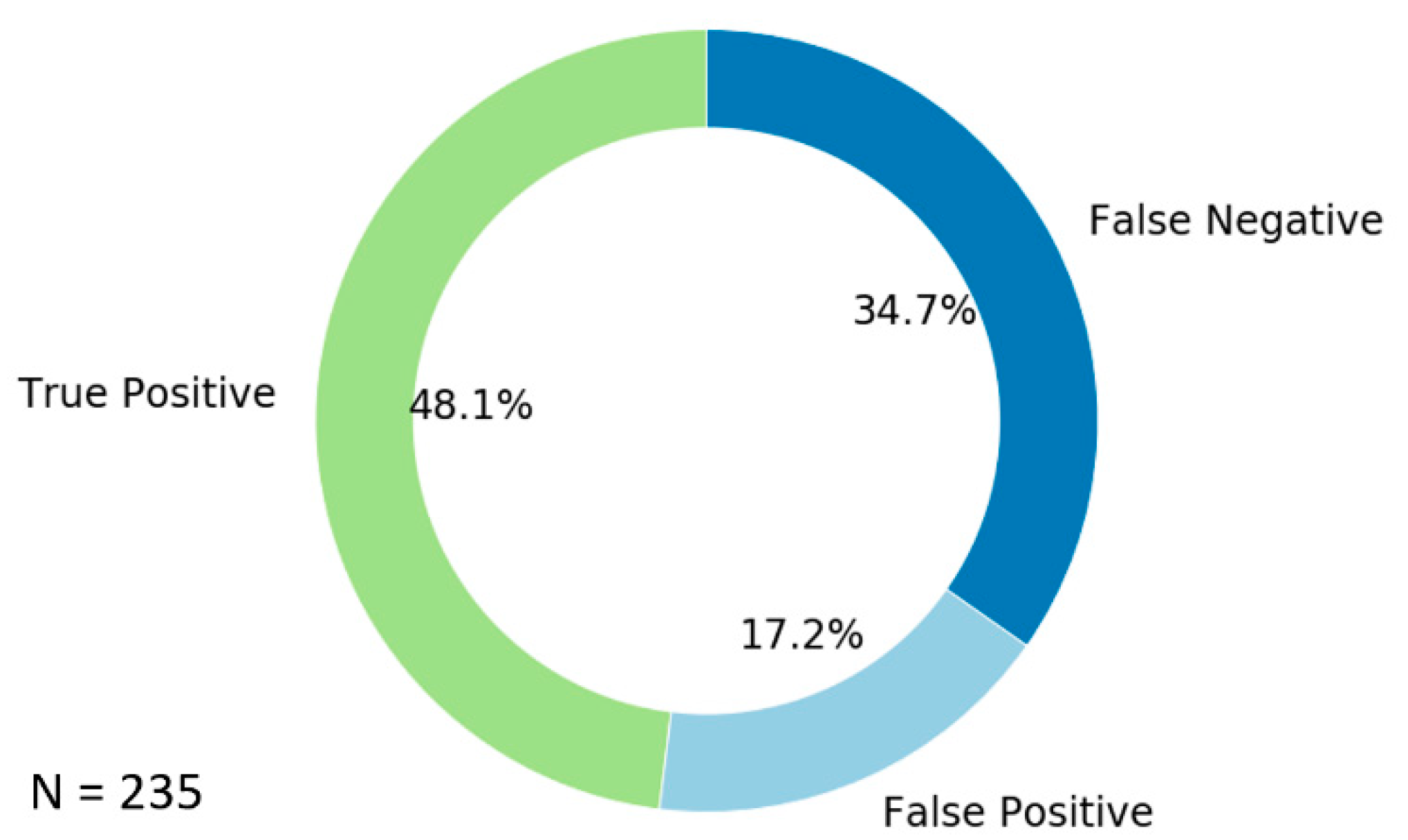Evaluating Satellite Sounding Temperature Observations for Cold Air Aloft Detection
Abstract
:1. Introduction
2. Data and Methods
2.1. NUCAPS Technical Description
2.2. COSMIC GPS-RO Technical Description
2.3. Matchup Criteria
3. Results
3.1. Evaluating NUCAPS Skill in Detecting CAA
3.2. Diagnosing Causes for True and False CAA Detection
- “Degrees of freedom of temperature” (dof_temp): The Trace of the AKM helps to diagnose the vertical resolution of the temperature retrieval. High values indicate high vertical resolution and may better capture CAA events, particularly when cold air layers are not very thick. Low values of dof_temp indicate a lower vertical resolution and the resulting profiles may smooth the small-scale features in the temperature profile. While DOFs are useful diagnostic metrics, DOFs are total column values and do not describe the vertical resolution at specific pressure levels (e.g., between 250 and 100 hPa).
- “Lapse Rate”: The lapse rate is the change in temperature with height in the atmosphere. In general, NUCAPS has larger uncertainty when the lapse rates are small. We categorize lapse rate into two pressure ranges that we identified as contributing to CAA detection, one between 250–100 hPa (lr250–100) and 500–250 hPa (lr500–250). Lr250–100 captures the atmospheric layer that typically contains the CAA, while lr500-250 is the “background” state and can influence the higher-level retrieval.
- “Cloud fraction” (cloud_frac): NUCAPS retrieves Cloud fraction (with values ranging from 0 as ‘cloud free” to 1.0 as “full cloud cover”) for each FOV from cloudy radiance measurements, then adds the 3 × 3 FOV fractions into a total cloud fraction for the FOR. As mentioned in Section 2.1, NUCAPS employs cloud clearing to retrieve temperature soundings for each FOR, which is successful in clear to partly cloudy scenes. To ensure confidence in the final retrieval, NUCAPS quantifies and propagates all known sources of uncertainty, which includes uncertainty due to clouds. Under some conditions, however, cloud uncertainty can be difficult to quantify and the retrieved temperature profile becomes cloud contaminated such that the portion of the profile underneath the cloud is cooler than it should be. Cloud fraction, alone, is not an indicator of cloud uncertainty or contamination. For instance, the quality of temperature profiles can be very good even in 85% cloudy FORs. We use cloud fraction in this study to improve our situational awareness of the atmospheric at the scenes in question and not as a measure of retrieval quality.
- “Chi-squared of cloud clearing” (eta_rej). For all channels used in the retrieved variable, eta_rej is the sum of the error in the cloud clearing radiance. Eta_rej is a function of the inverse of the derivative of the plank function for the channel as well as the difference between the estimated clear-sky radiance and the radiance that is calculated after the final cloud clearing step in NUCAPS. For scenes with high sensitivity (where dof_temp is high), smaller eta_rej values indicate that the cloud cleared radiance spectrum closely matches the estimated clear sky one and therefore likely has low cloud contamination (i.e., the radiative effects of clouds were accurately identified and removed). Values of eta_rej are high when NUCAPS fails to accurately detect and remove clouds during cloud clearing so the retrieved profiles become cloud contaminated. Cloud contamination often happens over cold scenes where the radiance signal is low and has weak sensitivity to temperature at multiple layers. Cloud contamination also can occur where the temperature difference between cloud tops and the snow-covered Earth surface are equivalent and hamper cloud detection. NUCAPS uses a threshold of 3.0 K for eta_rej as one of the metrics that informs its retrieval quality flag.
4. Discussion
5. Summary and Conclusions
Author Contributions
Funding
Acknowledgments
Conflicts of Interest
References
- Nav Canada. Polar Routes—Past, Present and Future. Available online: https://blog.navcanada.ca/polar-routes-past-present-future/ (accessed on 15 April 2019).
- Hoinka, K.P. Statistics of the Global Tropopause Pressure. Mon. Weather Rev. 1998, 126, 3303–3325. [Google Scholar] [CrossRef]
- Weaver, G.M.; Smith, N.; Berndt, E.B.; White, K.D.; Dostalek, J.F.; Zavodsky, B.T. Addressing the Cold Air Aloft Aviation Challenge with Satellite Sounding Observations. J. Oper. Meteorol. 2019, 138–152. [Google Scholar] [CrossRef]
- Susskind, J.; Barnet, C.D.; Blaisdell, J.M. Retrieval of atmospheric and surface parameters from AIRS/AMSU/HSB data in the presence of clouds. IEEE Trans. Geosci. Remote Sens. 2003, 41, 390–409. [Google Scholar] [CrossRef]
- Gambacorta, A.; Barnet, C.D. Methodology and Information Content of the NOAA NESDIS Operational Channel Selection for the Cross-Track Infrared Sounder (CrIS). IEEE Trans. Geosci. Remote Sens. 2012, 51, 3207–3216. [Google Scholar] [CrossRef]
- Gambacorta, A.; Nalli, N.R.; Barnet, C.D.; Tan, C.; Iturbide-Sanchez, F.; Zhang, K. The NOAA Unique Combined Atmospheric Processing System (NUCAPS) Algorithm Theoretical Basis Document. 2017. Available online: https://www.star.nesdis.noaa.gov/jpss/documents/ATBD/ATBD_NUCAPS_v2.0.pdf (accessed on 14 December 2020).
- Berndt, E.; Smith, N.; Burks, J.; White, K.; Esmaili, R.; Kuciauskas, A.; Duran, E.; Allen, R.; LaFontaine, F.; Szkodzinski, J. Gridded Satellite Sounding Retrievals in Operational Weather Forecasting: Product Description and Emerging Applications. Remote Sens. 2020, 12, 3311. [Google Scholar] [CrossRef]
- Esmaili, R.B.; Smith, N.; Berndt, E.B.; Dostalek, J.F.; Kahn, B.H.; White, K.; Barnet, C.D.; Sjoberg, W.; Goldberg, M. Adapting Satellite Soundings for Operational Forecasting within the Hazardous Weather Testbed. Remote Sens. 2020, 12, 886. [Google Scholar] [CrossRef] [Green Version]
- Nalli, N.R.; Gambacorta, A.; Liu, Q.; Barnet, C.D.; Tan, C.; Iturbide-Sanchez, F.; Reale, T.; Sun, B.; Wilson, M.; Borg, L.; et al. Validation of Atmospheric Profile Retrievals from the SNPP NOAA-Unique Combined Atmospheric Processing System. Part 1: Temperature and Moisture. IEEE Trans. Geosci. Remote Sens. 2018, 56, 180–190. [Google Scholar] [CrossRef]
- Sun, B.; Reale, A.; Tilley, F.H.; Pettey, M.E.; Nalli, N.R.; Barnet, C.D. Assessment of NUCAPS S-NPP CrIS/ATMS Sounding Products Using Reference and Conventional Radiosonde Observations. IEEE J. Sel. Top. Appl. Earth Obs. Remote Sens. 2017, 10, 2499–2509. [Google Scholar] [CrossRef]
- World Meteorological Organization (WMO). Guide to Aircraft-Based Observations, 2017th ed.; WMO: Geneva, Switzerland, 2017; ISBN 978-92-63-11200-2. [Google Scholar]
- NOAA. Soundings from ESRL/GSD. Available online: https://rucsoundings.noaa.gov/ (accessed on 7 November 2020).
- NOAA Radiosonde Observation. Available online: https://www.weather.gov/upperair/factsheet (accessed on 7 November 2020).
- Fett, R.W.; Englebretson, R.E.; Perryman, D.C. Forecasters Handbook for the Bering Sea, Aleutian Islands, and Gulf of Alaska; Defense Technical Information Center: Fort Belvoir, VA, USA, 1993. [Google Scholar]
- Esmaili, R. NUCAPS Quality Flag Quick Guide. Available online: https://weather.msfc.nasa.gov/nucaps/qg/NUCAPS-QF-quick-guide.pdf (accessed on 3 November 2020).
- Rodgers, C.D. Inverse Methods for Atmospheric Sounding: Theory and Practice; Series on Atmospheric Oceanic and Planetary Physics; Reprinted; World Scientific: Singapore, 2004; ISBN 978-981-02-2740-1. [Google Scholar]
- NOAA/STAR. Validated Maturity Science Review For NOAA-20 NUCAPS Algorithm. 2019. Available online: https://www.star.nesdis.noaa.gov/jpss/documents/AMM/N20/NUCAPS_Validated_CH4_Provisional.pdf (accessed on 14 December 2020).
- Smith, N.; Barnet, C.D. Uncertainty Characterization and Propagation in the Community Long-Term Infrared Microwave Combined Atmospheric Product System (CLIMCAPS). Remote Sens. 2019, 11, 1227. [Google Scholar] [CrossRef] [Green Version]
- Smith, N.; Barnet, C.D. CLIMCAPS Observing Capability for Temperature, Moisture and Trace Gases from AIRS/AMSU and CrIS/ATMS. Atmos. Meas. Tech. Discuss. 2020, 1–33. [Google Scholar] [CrossRef] [Green Version]
- Iturbide-Sanchez, F.; Liu, Q.; Gambacorta, A.; Barnet, C.; Nalli, N.R.; Tan, C.; Santos da Silva, S.R. Using averaging kernels to study the vertical resolution of nucaps temperature and water vapor. In Proceedings of the 2017 IEEE International Geoscience and Remote Sensing Symposium (IGARSS), Fort Worth, TX, USA, 23–28 July 2017; pp. 33–35. [Google Scholar]
- Ho, S.; Anthes, R.A.; Ao, C.O.; Healy, S.; Horanyi, A.; Hunt, D.; Mannucci, A.J.; Pedatella, N.; Randel, W.J.; Simmons, A.; et al. The COSMIC/FORMOSAT-3 Radio Occultation Mission after 12 Years: Accomplishments, Remaining Challenges, and Potential Impacts of COSMIC-2. Bull. Am. Meteorol. Soc. 2020, 101, E1107–E1136. [Google Scholar] [CrossRef] [Green Version]
- Anthes, R.A.; Bernhardt, P.A.; Chen, Y.; Cucurull, L.; Dymond, K.F.; Ector, D.; Healy, S.B.; Ho, S.-P.; Hunt, D.C.; Kuo, Y.-H.; et al. THE COSMIC/FORMOSAT-3 MISSION: Early Results. Bull. Am. Meteorol. Soc. 2008, 89, 313–333. [Google Scholar] [CrossRef]
- Schreiner, W.; Rocken, C.; Sokolovskiy, S.; Syndergaard, S.; Hunt, D. Estimates of the precision of GPS radio occultations from the COSMIC/FORMOSAT-3 mission. Geophys. Res. Lett. 2007, 34. [Google Scholar] [CrossRef] [Green Version]
- UCAR. CDAAC: COSMIC Data Analysis and Archive Center—Data Products. Available online: https://cdaac-www.cosmic.ucar.edu/cdaac/products.html (accessed on 17 November 2020).
- Feltz, M.L.; Knuteson, R.; Weisz, E.; Smith, N.; Feltz, W.; Ackerman, S.A. Towards Aiding Aviation Safety: Detection of Cold Air Aloft Using COSMIC RO and AIRS Hyperspectral IR Sounder (96th American Meteorological Society Annual Meeting). In Proceedings of the 12th Annual Symposium on New Generation Operational Environmental Satellite Systems, New Orleans, LA, USA, 10–14 January 2016. [Google Scholar]
- Feltz, M.; Knuteson, R.O.; Revercomb, H.E.; Tobin, D.C. A methodology for the validation of temperature profiles from hyperspectral infrared sounders using GPS radio occultation: Experience with AIRS and COSMIC. J. Geophys. Res. Atmos. 2014, 119, 1680–1691. [Google Scholar] [CrossRef]
- Morss, R.E.; Demuth, J.L.; Lazo, J.K. Communicating Uncertainty in Weather Forecasts: A Survey of the U.S. Public Weather Forecast. 2008, 23, 974–991. [Google Scholar] [CrossRef]
- Hirschberg, P.A.; Abrams, E.; Bleistein, A.; Bua, W.; Monache, L.D.; Dulong, T.W.; Gaynor, J.E.; Glahn, B.; Hamill, T.M.; Hansen, J.A.; et al. A Weather and Climate Enterprise Strategic Implementation Plan for Generating and Communicating Forecast Uncertainty Information. Bull. Am. Meteorol. Soc. 2011, 92, 1651–1666. [Google Scholar] [CrossRef] [Green Version]
- Smith, N.; Shontz, K.; Barnet, C.D. What is a Satellite Measurement? Communicating Abstract Satellite Science Concepts to the World; AMS: Austin, TX, USA, 2018. [Google Scholar]
- SSEC Data Center Polar Orbit Tracks. Available online: https://www.ssec.wisc.edu/datacenter/orbit_tracks.html (accessed on 9 December 2020).
- CIRA. RAMMB: RAMSDIS Online—Cold Air Aloft. Available online: http://rammb.cira.colostate.edu/ramsdis/online/cold_air_aloft.asp (accessed on 3 November 2020).






| State | NUCAPS | COSMIC |
|---|---|---|
| True Positive | Detected | Detected |
| True Negative | Not Detected | Not Detected |
| False Negative | Not Detected | Detected |
| False Positive | Detected | Not Detected |
Publisher’s Note: MDPI stays neutral with regard to jurisdictional claims in published maps and institutional affiliations. |
© 2020 by the authors. Licensee MDPI, Basel, Switzerland. This article is an open access article distributed under the terms and conditions of the Creative Commons Attribution (CC BY) license (http://creativecommons.org/licenses/by/4.0/).
Share and Cite
Esmaili, R.; Smith, N.; Schoeberl, M.; Barnet, C. Evaluating Satellite Sounding Temperature Observations for Cold Air Aloft Detection. Atmosphere 2020, 11, 1360. https://doi.org/10.3390/atmos11121360
Esmaili R, Smith N, Schoeberl M, Barnet C. Evaluating Satellite Sounding Temperature Observations for Cold Air Aloft Detection. Atmosphere. 2020; 11(12):1360. https://doi.org/10.3390/atmos11121360
Chicago/Turabian StyleEsmaili, Rebekah, Nadia Smith, Mark Schoeberl, and Chris Barnet. 2020. "Evaluating Satellite Sounding Temperature Observations for Cold Air Aloft Detection" Atmosphere 11, no. 12: 1360. https://doi.org/10.3390/atmos11121360
APA StyleEsmaili, R., Smith, N., Schoeberl, M., & Barnet, C. (2020). Evaluating Satellite Sounding Temperature Observations for Cold Air Aloft Detection. Atmosphere, 11(12), 1360. https://doi.org/10.3390/atmos11121360





